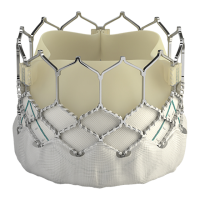4
mishandled or damaged during any part of the procedure will require replacement of the valve.
• Caution should be exercised in implanting a valve in patients with clinically significant coronary artery
disease.
• Patients with pre-existing mitral valve devices should be carefully assessed prior to implantation of
the valve to ensure proper valve positioning and deployment.
• Do not use the valve if the tamper evident seal is broken, the storage solution does not completely
cover the valve, the temperature indicator has been activated, the valve is damaged, or the expiration
date has elapsed.
• Do not mishandle the delivery system or use it if the packaging or any components are not sterile,
have been opened or are damaged (e.g. kinked or stretched), or the expiration date has elapsed.
• Use of excessive contrast media may lead to renal failure. Measure the patient’s creatinine level prior
to the procedure. Contrast media usage should be monitored.
• Patient injury could occur if the delivery system is not un-flexed prior to removal.
• Care should be exercised in patients with hypersensitivities to cobalt, nickel, chromium, molybdenum,
titanium, manganese, silicon, and/or polymeric materials.
• The procedure should be conducted under fluoroscopic guidance. Some fluoroscopically guided
procedures are associated with a risk of radiation injury to the skin. These injuries may be painful,
disfiguring, and long-lasting.
• Valve recipients should be maintained on anticoagulant/antiplatelet therapy, except when
contraindicated, as determined by their physician. This device has not been tested for use without
anticoagulation.
• Do not add or apply antibiotics to the storage solution, rinse solutions, or to the valve.
5.0 Precautions
• Long-term durability has not been established for the valve. Regular medical follow-up is advised to
evaluate valve performance.
• Glutaraldehyde may cause irritation of the skin, eyes, nose and throat. Avoid prolonged or repeated
exposure to, or breathing of, the solution. Use only with adequate ventilation. If skin contact occurs,
immediately flush the affected area with water; in the event of contact with eyes, seek immediate
medical attention. For more information about glutaraldehyde exposure, refer to the Material Safety
Data Sheet available from Edwards Lifesciences.
• To maintain proper valve leaflet coaptation, do not overinflate the deployment balloon.
• Appropriate antibiotic prophylaxis is recommended post-procedure in patients at risk for prosthetic
valve infection and endocarditis.
• Safety, effectiveness, and durability have not been established for valve-in-valve procedures.
• Safety and effectiveness have not been established for patients with the following
characteristics/comorbidities:
o Non-calcified aortic annulus
o Severe ventricular dysfunction with ejection fraction < 20%
o Congenital unicuspid or congenital bicuspid aortic valve
o Mixed aortic valve disease (aortic stenosis and aortic regurgitation with predominant aortic
regurgitation > 3+)
o Pre-existing prosthetic heart valve or prosthetic ring in any position
o Severe mitral annular calcification (MAC), severe (> 3+) mitral insufficiency, or Gorlin
syndrome

